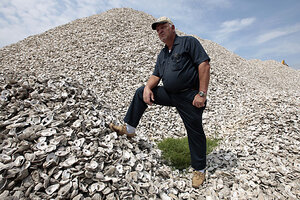One year later: Louisiana seafood still in flux
Historically, certain seafood served in the US has come from Louisiana. But since the BP oil spill last year, the state's seafood output has plummeted.

In this Thursday, April 14, 2011 picture, Mayor Stan Wright stands atop a pile of oysters in Bayou La Batre, Ala. The small fishing town is struggling to survive following the Deepwater Horizon oil spill that occurred nearly a year ago.
Dave Martin / AP
By Brian A. Shactman, CNBC.com
If you go out to your local seafood restaurant, you might order oysters or shrimp, but the odds are it might not be from Louisiana.
One year after the tragic BP oil spill that killed 11 people and resulted in the worst offshore oil spill in American history, Louisiana's $2.4 billion seafood industry is a long way from returning to previous levels—both in supply and demand.
Take oysters for example. Historically, 20 percent of oysters in this country come from Louisiana. But with beds shut down most of last year, 2010 production was half that of the year before. This year could be worse, even if a majority of harvesting areas remain open.
Reasons for the supply collapse abound.
Various reports and studies say the state's decision to divert fresh water to certain areas to push back the oil resulted in dead oyster beds. Also, oysters businesses couldn't seed new beds.
Finally, several oystermen tell CNBC they think a lot of baby oysters have been killed by the oil, the chemical dispersant or the fresh water.
"We expect it could be way down," said John Tesvich, president of Ameripure Oysters, which is the sole provider to Darden Restaurants . "We really won't know for sure until later in the summer."
Before the oil spill, Ameripure oysters were on the permanent menu at Darden's Red Lobster. Not anymore, and Tesvich does not know when that will change. For now, Ameripure is processing oysters mostly from Texas, with shipments from Louisiana starting to trickle in.
The shrimping season is just starting to open up, and no one seems to know what the supply will be like.
"We have never had stock issues in the Gulf of Mexico," said Clint Guidry, who is president of the Louisiana Shrimp Association. "I think it's going to take time to see what effects 200 million gallons of oil and two million gallons of dispersant had on that.
"That's something I can't predict. I'm just a fisherman. I can't tell you what's going to happen."
It's a different situation for charter-boat fisherman who take customers out to catch everything from red fish and speckled trout to tuna. Their supply is abundant and thus far found to be healthy. But there just aren't enough people out there who want to fish the Gulf right now.
"The perception of people from out of town is that they never saw a closure and all they saw was oil, oil, oil," said Brent Roy, who operates several charter boats and can earn from $600 to $1,500 per trip. "The general perception is that there's oil everywhere and that's not the case."
Perception is just as much a concern as supply in Louisiana, and both are mostly unknown one year after the tragic spill.
"From a production standpoint, we'll be down 50 percent or so this year," said Mike Voisin, who runs Motivatit, an oyster processing competitor to Ameripure. "Next year, we may be down 40 percent."
He says Motivatit could be at 100 percent capacity in four years...if demand returns. "It's only if the market accepts it."
